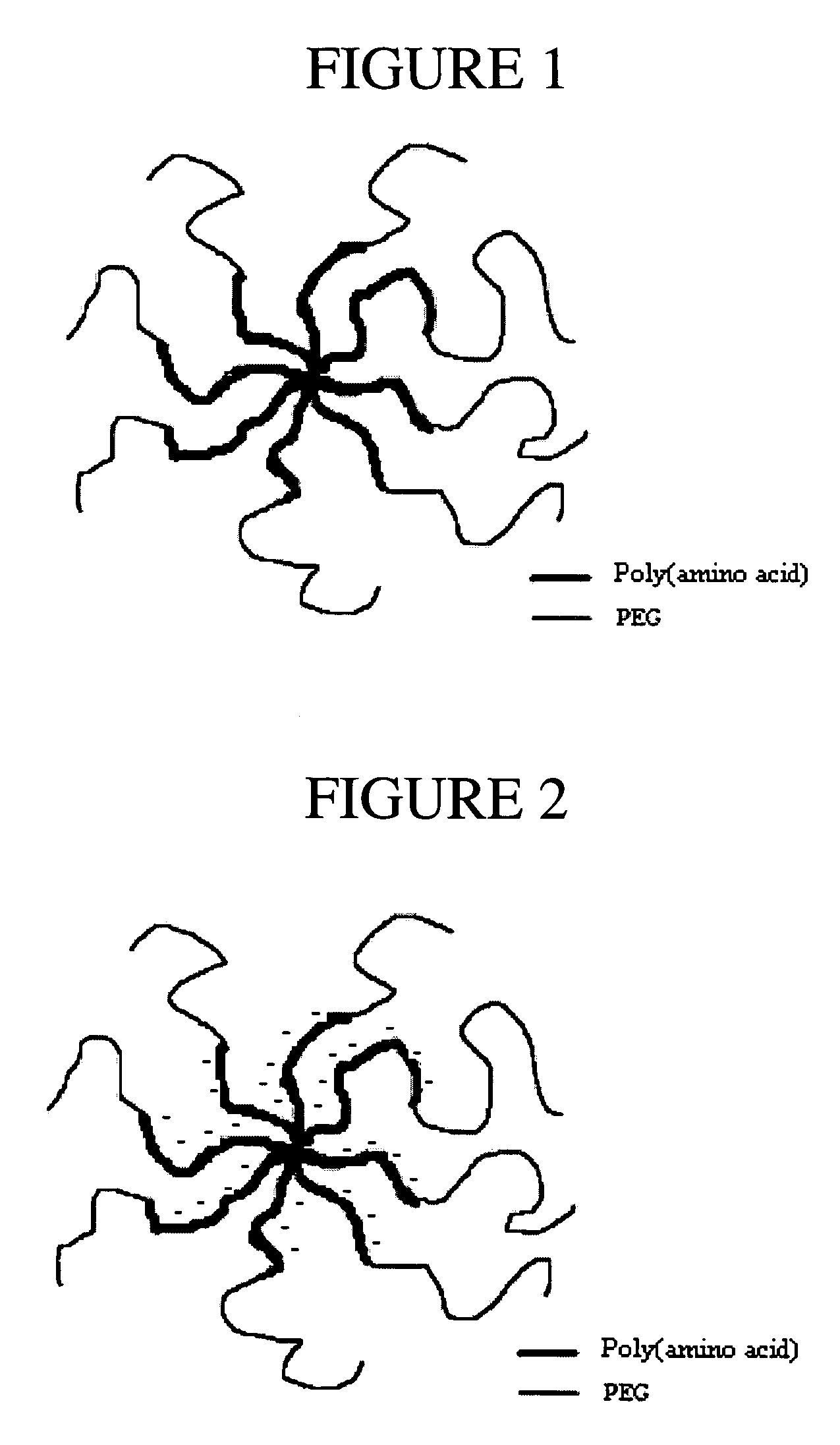Multi-arm polypeptide-poly (ethylene glycol) block copolymers as drug delivery vehicles
- Summary
- Abstract
- Description
- Claims
- Application Information
AI Technical Summary
Benefits of technology
Problems solved by technology
Method used
Image
Examples
example 1
Synthesis of N-Carboxyanhydride (NCA) of L-Aspartic Acid β-Benzyl Ester
[0154]
[0155]L-aspartic acid β-benzyl ester (Sigma-Aldrich) was suspended in 225 ml of tetrahydrofuran (THF). To the suspension was added approximately 13 g of bis(trichloromethyl) carbonate dissolved in 25 ml of THF, and the mixture stirred at 50° C. until a solution was obtained. The solvent was removed under vacuum. THF was added gradually to the solid residue at 65° C. until the material was completely dissolved. Hexane was added and the solution was gradually cooled to −15° C. The resulting powder was filtered and the product was recrystallized twice and dried at room temperature in vacuo. 1H NMR(DMSO-d6): δ 2.98 (dxd, —CHCH2COO—), 4.69 (t, —CHCH2COO—), 5.13 (s, CH2—C6H6H5—), 7.35 (m, aromatic H).
example 2
Synthesis of N-Carboxyanhydride (NCA) of L-Glutamic Acid γ-Benzyl Ester
[0156]
[0157]25 grams of L-glutamic acid γ-benzyl ester (Sigma-Aldrich) was suspended in 250 ml of THF. To the suspension was added approximately 12.3 g of bis(trichloromethyl) carbonate dissolved in 25 ml of THF. The mixture was stirred at 50° C. until a transparent solution was obtained and the solvent was removed under vacuum. The solid residue was recrystallized twice from a mixture of THF / hexane and the product dried at room temperature in vacuo. 1H NMR(DMSO-d6):δ 1.94 (m, —CHCH2CH2COO—), 2.07 (m, —CHCH2CH 2COO—), 4.45(t, —CHCH2CH2COO—), 5.1 (s, CH2—C6H5—), 7.35 (m, aromatic H).
example 3
Synthesis of N-Carboxyanhydride of N-ε-Cbz-Lysine
[0158]
[0159]N-ε-Benzyloxycarbonyl-lysine (“N-ε-Cbz-lysine,” 50 g, Sigma-Aldrich) was suspended in 500 ml of THF. To the suspension was added 21.2 g of bis(trichloromethyl) carbonate dissolved in 50 ml of THF. The reaction mixture was heated to 50° C. while stirring. After the reaction mixture became transparent (about 15 to 45 minutes), the solution was stirred at 50° C. for another hour. The solution was cooled to room temperature, filtered and the filtrate added to 1,500 ml of hexane. The hexane solution was cooled at−20° C. for 2-3 hours and the resulting precipitate was collected by filtration and further purified by recrystallization from THF / hexane. The product was dried under vacuum. 1H NMR(DMSO-d6): δ 1.33 (m, —CHCH2CH2CH2CH2COO—), 1.68 (m, CHCH2CH2CH2C H2COO—), 4.42(t, —CHCH2CH2—), 5.0 (s, CH2—C6H5—), 7.31 (m, aromatic H).
PUM
| Property | Measurement | Unit |
|---|---|---|
| Mass | aaaaa | aaaaa |
| Mass | aaaaa | aaaaa |
| Mass | aaaaa | aaaaa |
Abstract
Description
Claims
Application Information
 Login to View More
Login to View More - R&D
- Intellectual Property
- Life Sciences
- Materials
- Tech Scout
- Unparalleled Data Quality
- Higher Quality Content
- 60% Fewer Hallucinations
Browse by: Latest US Patents, China's latest patents, Technical Efficacy Thesaurus, Application Domain, Technology Topic, Popular Technical Reports.
© 2025 PatSnap. All rights reserved.Legal|Privacy policy|Modern Slavery Act Transparency Statement|Sitemap|About US| Contact US: help@patsnap.com



